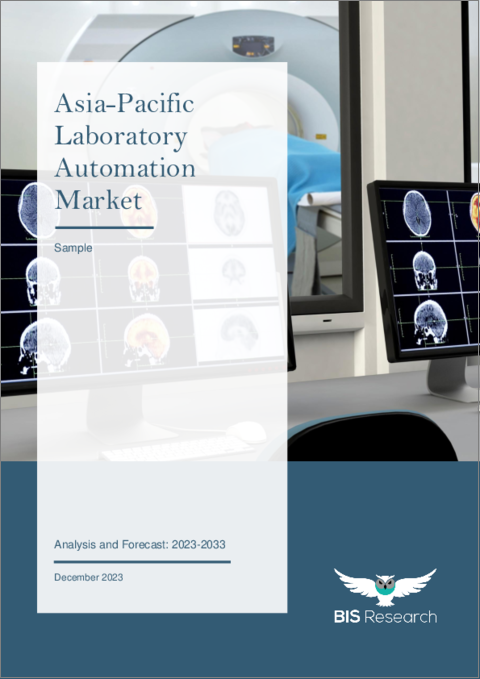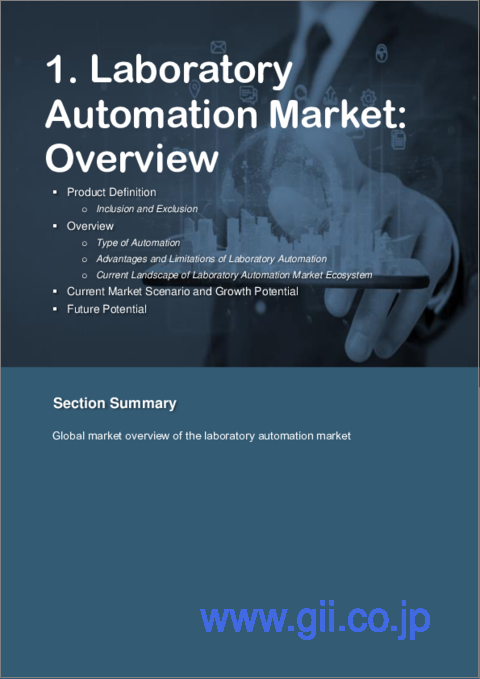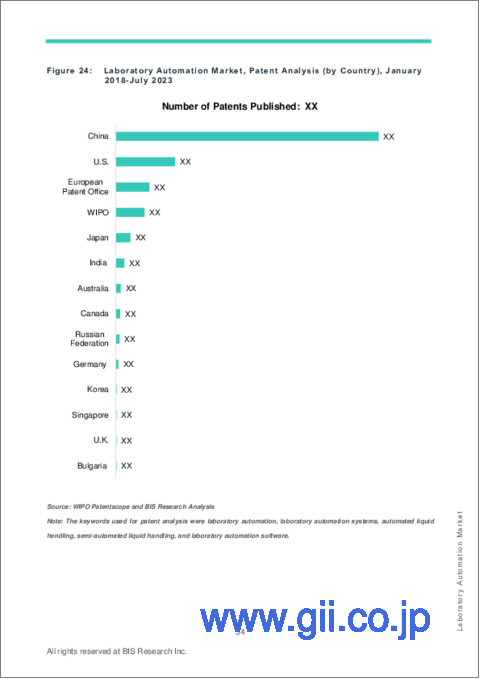|
|
市場調査レポート
商品コード
1398978
アジア太平洋のラボラトリーオートメーション市場: - 分析と予測(2023年~2033年)Asia-Pacific Laboratory Automation Market: Analysis and Forecast, 2023-2033 |
||||||
|
● お客様のご希望に応じて、既存データの加工や未掲載情報(例:国別セグメント)の追加などの対応が可能です。 詳細はお問い合わせください。 |
|||||||
| アジア太平洋のラボラトリーオートメーション市場: - 分析と予測(2023年~2033年) |
|
出版日: 2023年12月26日
発行: BIS Research
ページ情報: 英文 104 Pages
納期: 1~5営業日
|
- 全表示
- 概要
- 図表
- 目次
アジア太平洋のラボラトリーオートメーションの市場規模は、2022年に11億7,000万米ドルとなりました。
同市場は、2023年~2033年の予測期間中に11.03%のCAGRで拡大し、2033年末までに36億9,000万米ドルに達すると予測されています。実験室の自動化とは、多様な実験室作業、調査、評価を最小限の人的関与で実施するための技術と装置の活用に関連します。科学研究、試験、実験のスループット、精度、再現性、効率の向上がラボラトリーオートメーションの目的です。
| 主要市場統計 | |
|---|---|
| 予測期間 | 2023年~2033年 |
| 2023年評価 | 12億9,000万米ドル |
| 2033年予測 | 36億9,000万米ドル |
| CAGR | 11.03% |
アジア太平洋のラボラトリーオートメーション市場は、リキッドハンドリング機器、器具、アクセサリー、ソフトウェアなど、複数の製品カテゴリーに区分されています。リキッドハンドリング機器カテゴリーでは、完全自動化および半自動化システム、ならびにラボラトリー情報管理システム(LIMS)ソフトウェアやリキッドハンドリングシステムソフトウェアなどのソフトウェア選択が提供されます。創薬、医薬品開発、細胞培養、再生医療、ゲノミクス、分子生物学、臨床診断を含む数多くの用途は、これらのリキッドハンドリングツールに大きく依存しています。ライフサイエンスおよびバイオ医薬品産業、診断ラボ、開発業務受託機関(CRO)、研究開発・製造業務受託機関(CDMO)、研究・学術機関が、これらの機器の主なターゲット消費者です。
当レポートでは、アジア太平洋のラボラトリーオートメーション市場について調査し、市場の概要とともに、製品別、国別の動向、および市場に参入する企業のプロファイルなどを提供しています。
目次
エグゼクティブサマリー
調査範囲
調査手法
第1章 ラボラトリーオートメーション市場
- 製品の定義
- 概要
- 現在の市場シナリオと成長の可能性
- 将来性
第2章 ラボラトリーオートメーション市場:業界分析
- 主要な動向
- 機会の評価
- 規制の枠組み
- 特許分析
- Van Westendropの価格分析
- ステークホルダー分析(N=30)
第3章 市場力学
- 影響分析
- ビジネスの促進要因
- ビジネスの抑制要因
- ビジネスの機会
第4章 地域
- アジア太平洋
- 主な調査結果
- 市場力学
- 市場規模と予測
第5章 企業プロファイル
- MGI Tech Co., Ltd.
List of Figures
- Figure 1: Advantages of Laboratory Automation
- Figure 2: Laboratory Automation Market, $Billion, 2022-2033
- Figure 3: Laboratory Automation Market, Market Dynamics
- Figure 4: Key Trends in the Laboratory Automation Market
- Figure 5: Laboratory Automation Market Share (by Product Type), 2022 and 2033
- Figure 6: Laboratory Automation Market (by Region), $Billion, 2022
- Figure 7: Key Developments and Strategies Analysis, January 2020-July 2023
- Figure 8: Laboratory Automation Market: Research Methodology
- Figure 9: Primary Research Methodology
- Figure 10: Bottom-Up Approach (Segment-Wise Analysis)
- Figure 11: Top-Down Approach (Segment-Wise Analysis)
- Figure 12: Advantages of Laboratory Automation
- Figure 13: Limitations of Laboratory Automation
- Figure 14: Ecosystem of the Laboratory Automation Market
- Figure 15: Laboratory Automation Market, Size and Growth Potential, $Billion, 2022-2033
- Figure 16: Key Advantages of Software Integration Leading to Reduced Error and Increased Efficiency
- Figure 17: Complete Management of Laboratory Facilities with Software Integration
- Figure 18: Advantages of Miniaturization of Laboratory Automation Systems
- Figure 19: Companies Offering Miniaturized Laboratory Automation Products
- Figure 20: Advantages of Integrating Artificial Intelligence into Laboratory Automation
- Figure 21: Laboratory Automation Market, Key Trends, Opportunity Assessment, 2023-2033
- Figure 22: Communication Flow in the Laboratory Automation Environment According to AUTO3-P
- Figure 23: Laboratory Automation Market, Patent Analysis (by Year), January 2018-July 2023
- Figure 24: Laboratory Automation Market, Patent Analysis (by Country), January 2018-July 2023
- Figure 25: Van Westendorp Pricing Analysis, Semi-Automated Systems
- Figure 26: Van Westendorp Pricing Analysis, Fully Automated Systems
- Figure 27: Factors Increasing the Adoption of Laboratory Automation According to Stakeholders
- Figure 28: Challenges in the Adoption of Laboratory Automation According to Stakeholders
- Figure 29: Factors Increasing the Adoption of Laboratory Automation According to Stakeholders
- Figure 30: Challenges in Adoption of Laboratory Automation According to Stakeholders
- Figure 31: Laboratory Automation Market, Impact Analysis
- Figure 32: Case Study: "Hermes Pardini Redefines Operational Excellence for Extreme High-Volume Testing," Siemens Healthineers
- Figure 33: Comparison of Experiment Running Costs with Standard Methods and Automated Methods
- Figure 34: Lack of Skilled Professionals in Laboratories: Survey Results
- Figure 35: Laboratory Staff Optimization with Automation
- Figure 36: Technological Advancements in Laboratory Automation
- Figure 37: Challenges in Integrating Laboratory Automation Solutions within the Existing Laboratory
- Figure 38: Gains from Partnerships and Alliances by Market Players
- Figure 39: Adoption Rates for Laboratory Automation Solutions in Emerging Countries
- Figure 40: Laboratory Automation Market Share (by Region), 2022-2033
- Figure 41: Asia-Pacific Laboratory Automation Market, Incremental Opportunity (by Country), $Billion, 2023-2033
- Figure 42: Asia-Pacific Laboratory Automation Market, $Billion, 2022-2033
- Figure 43: Asia-Pacific Laboratory Automation Market (by Product Type), $Million, 2022-2033
- Figure 44: Asia-Pacific Laboratory Automation Market (Liquid Handling), Unit Sold, 2022-2033
- Figure 45: Asia-Pacific Laboratory Automation Market (by Country), Share (%), 2022 and 2033
- Figure 46: Japan Laboratory Automation Market, $Million, 2022-2033
- Figure 47: Japan Laboratory Automation Market (by Product Type), $Million, 2022-2033
- Figure 48: Japan Laboratory Automation Market (Liquid Handling) Unit Sold, 2022-2033
- Figure 49: China Laboratory Automation Market, $Million, 2022-2033
- Figure 50: China Laboratory Automation Market (by Product Type), $Million, 2022-2033
- Figure 51: China Laboratory Automation Market (Liquid Handling), Unit Sold, 2022-2033
- Figure 52: India Laboratory Automation Market, $Million, 2022-2033
- Figure 53: India Laboratory Automation Market (by Product Type), $Million, 2022-2033
- Figure 54: India Laboratory Automation Market (Liquid Handling) Unit Sold, 2022-2033
- Figure 55: Australia Laboratory Automation Market, $Million, 2022-2033
- Figure 56: Australia Laboratory Automation Market (by Product Type), $Million, 2022-2033
- Figure 57: Australia Laboratory Automation Market (Liquid Handling) Unit Sold, 2022-2033
- Figure 58: South Korea Laboratory Automation Market, $Million, 2022-2033
- Figure 59: South Korea Laboratory Automation Market (by Product Type), $Million, 2022-2033
- Figure 60: South Korea Laboratory Automation Market (Liquid Handling), Unit Sold, 2022-2033
- Figure 61: Rest-of-Asia-Pacific Laboratory Automation Market, $Million, 2022-2033
- Figure 62: Rest-of-Asia-Pacific Laboratory Automation Market (by Product Type), $Million, 2022-2033
- Figure 63: Rest-of-Asia-Pacific Laboratory Automation Market (Liquid Handling), Unit Sold, 2022-2033
- Figure 1: Company Overview
List of Tables
- Table 1: Key Questions Answered in the Report
- Table 2: Cost of Some Laboratory Automation Solutions Offered by Opentrons
- Table 3: Asia-Pacific Laboratory Automation Market, Impact Analysis
Introduction to Asia-Pacific (APAC) Laboratory Automation Market
The Asia-Pacific laboratory automation market was valued at $1.17 billion in 2022 and is expected to reach $3.69 billion by the end of 2033, registering a CAGR of 11.03% during the forecast period 2023-2033. Laboratory automation pertains to the utilization of technology and apparatus to carry out diverse laboratory operations, investigations, and evaluations with the least amount of human involvement. Increasing scientific research, testing, and experimentation throughput, accuracy, reproducibility, and efficiency are the aims of laboratory automation.
Market Introduction
| KEY MARKET STATISTICS | |
|---|---|
| Forecast Period | 2023 - 2033 |
| 2023 Evaluation | $1.29 Billion |
| 2033 Forecast | $3.69 Billion |
| CAGR | 11.03% |
The laboratory automation market in Asia-Pacific has been segmented into multiple product categories, encompassing liquid handling equipment, appliances, accessories, and software. Fully automated and semi-automated systems, as well as software choices such laboratory information management system (LIMS) software and liquid handling system software, are offered by the liquid handling instruments category. Numerous applications, including drug discovery, pharmaceutical development, cell culture, regenerative medicine, genomics, molecular biology, and clinical diagnostics, depend heavily on these liquid handling tools. The life sciences and biopharmaceutical industries, diagnostic labs, contract research organizations (CROs), contract development and manufacturing organizations (CDMOs), and research and academic institutions are the main target consumers of these instruments.
Market Segmentation:
Segmentation 1: by Product
- Liquid Handling
- Appliances and Accessories
- Software
Based on product type, the liquid handling segment held the largest share of the market in 2022, and the trend is anticipated to continue during the forecast period 2023-2033.
Segmentation 2: by Country
- Japan
- India
- China
- South Korea
- Australia
- Rest-of-Asia-Pacific
Japan held the largest share in the regional market, and the trend is anticipated to continue during the forecast period 2023-2033.
How Can This Report Add Value to an Organization?
Product/Innovation Strategy: The Asia-Pacific laboratory automation market has been segmented on the basis of various categories, such as product and country. The product segment has been further sub-segmented into semi-automated and fully automated liquid handling systems. This can help readers get a clear overview of which segments account for the largest share and which ones are well-positioned to grow in the coming years.
Competitive Strategy: The Asia-Pacific laboratory automation market is a highly fragmented market, with many smaller and private companies constantly entering the market. Key players in the Asia-Pacific laboratory automation market analyzed and profiled in the study involve established players that offer various kinds of instruments, appliances and accessories and software.
Table of Contents
Executive Summary
Scope of the Study
Research Methodology
1. Laboratory Automation Market
- 1.1. Product Definition
- 1.1.1. Inclusion and Exclusion Criteria
- 1.2. Overview
- 1.2.1. Type of Automation
- 1.2.1.1. Fixed Automation
- 1.2.1.2. Programmable Automation
- 1.2.1.3. Flexible Automation
- 1.2.1.4. Integrated Automation
- 1.2.2. Advantages of Laboratory Automation
- 1.2.3. Limitations of Laboratory Automation
- 1.2.4. Current Landscape of Laboratory Automation Market
- 1.2.1. Type of Automation
- 1.3. Current Market Scenario and Growth Potential
- 1.4. Future Potential
2. Laboratory Automation Market: Industry Analysis
- 2.1. Key Trends
- 2.1.1. Integration of Software alongside Laboratory Automation Systems
- 2.1.2. Miniaturization of the Laboratory Automation Systems
- 2.1.3. Integration of Artificial Intelligence
- 2.2. Opportunity Assessment
- 2.3. Regulatory Framework
- 2.3.1. Overview
- 2.3.2. Clinical and Laboratory Standards Institute (CLSI)
- 2.3.3. Regulatory Framework According to Laboratory Type
- 2.4. Patent Analysis
- 2.4.1. Patent Analysis (by Year)
- 2.4.2. Patent Analysis (by Country)
- 2.5. Van Westendrop Pricing Analysis
- 2.5.1. Overview
- 2.5.2. Semi-Automated Systems
- 2.5.3. Fully-Automated Systems
- 2.6. Stakeholder Analysis (N=30)
- 2.6.1. Demand-Side Perception
- 2.6.1.1. Factors Increasing the Adoption of Laboratory Automation
- 2.6.1.2. Challenges in Adoption of Laboratory Automation
- 2.6.2. Supply-Side Perception
- 2.6.2.1. Factors Increasing the Adoption of Laboratory Automation
- 2.6.2.2. Challenges in Adoption of Laboratory Automation
- 2.6.1. Demand-Side Perception
3. Market Dynamics
- 3.1. Impact Analysis
- 3.2. Business Drivers
- 3.2.1. Improved Turn-Around Time and Reduced Cost by Implementing Laboratory Automation
- 3.2.2. Increased Demand for Laboratory Automation due to Shortage of Skilled Laboratory Staff
- 3.2.3. Technological Advancements in the Field of Laboratory Automation
- 3.2.4. Increasing Funding Activities in the Market
- 3.3. Business Restraints
- 3.3.1. High Capital Investment and Maintenance Costs
- 3.3.2. Complexity of Integration with Existing Laboratory
- 3.4. Business Opportunities
- 3.4.1. Partnerships and Alliances Creating an Opportunity for Growth
- 3.4.2. Increasing Opportunity for Laboratory Automation in Emerging Economies
4. Regions
- 4.1. Asia-Pacific
- 4.1.1. Key Findings
- 4.1.2. Market Dynamics
- 4.1.2.1. Impact Analysis
- 4.1.3. Market Sizing and Forecast
- 4.1.3.1. Asia-Pacific Laboratory Automation Market (by Product Type), $Million, 2022-2033
- 4.1.3.1.1. Asia-Pacific Laboratory Automation Market (Liquid handling), Unit Sold, 2022-2033
- 4.1.3.2. Asia-Pacific Laboratory Automation Market (by Country)
- 4.1.3.2.1. Japan
- 4.1.3.2.1.1. Market Dynamics
- 4.1.3.2.1.2. Market Sizing and Forecast
- 4.1.3.2.1.2.1. Japan Laboratory Automation Market (by Product Type), $Million, 2022-2033
- 4.1.3.2.2. China
- 4.1.3.2.2.1. Market Dynamics
- 4.1.3.2.2.2. Market Sizing and Forecast
- 4.1.3.2.2.2.1. China Laboratory Automation Market (by Product Type), $Million, 2022-2033
- 4.1.3.2.3. India
- 4.1.3.2.3.1. Market Dynamics
- 4.1.3.2.3.2. Market Sizing and Forecast
- 4.1.3.2.3.2.1. India Laboratory Automation Market (by Product Type), $Million, 2022-2033
- 4.1.3.2.4. Australia
- 4.1.3.2.4.1. Market Dynamics
- 4.1.3.2.4.2. Market Sizing and Forecast
- 4.1.3.2.4.2.1. Australia Laboratory Automation Market (by Product Type), $Million, 2022-2033
- 4.1.3.2.5. South Korea
- 4.1.3.2.5.1. Market Dynamics
- 4.1.3.2.5.2. Market Sizing and Forecast
- 4.1.3.2.5.2.1. South Korea Laboratory Automation Market (by Product Type), $Million, 2022-2033
- 4.1.3.2.6. Rest-of-Asia-Pacific
- 4.1.3.2.6.1. Market Dynamics
- 4.1.3.2.6.2. Market Sizing and Forecast
- 4.1.3.2.6.2.1. Rest-of-Asia-Pacific Laboratory Automation Market (by Product Type), $Million, 2022-2033
- 4.1.3.2.1. Japan
- 4.1.3.1. Asia-Pacific Laboratory Automation Market (by Product Type), $Million, 2022-2033
5. Company Profile
- 5.1. MGI Tech Co., Ltd.
- 5.1.1. Role of MGI Tech Co., Ltd. in the Laboratory Automation Market
- 5.1.2. Recent Developments
- 5.1.3. Analyst Perspective




